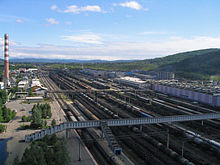Tynda
| city
Tynda
Tynда
|
||||||||||||||||||||||||||||||||||||||||||||
|
||||||||||||||||||||||||||||||||||||||||||||
|
||||||||||||||||||||||||||||||||||||||||||||
| List of cities in Russia | ||||||||||||||||||||||||||||||||||||||||||||
Tynda ( Russian Тында ) is a city in the Amur Oblast ( Russia ) with 36,275 inhabitants (as of October 14, 2010).
geography
The city is located south of the Stanovoi Mountains in the Far East of Russia , about 570 kilometers (as the crow flies) northwest of the Oblast capital Blagoveshchensk . In Tynda the Getkan flows into the river Tynda , after which the city was named; this in turn flows a few kilometers east into the Seja tributary Giljui .
Tynda is the administrative center of the Tynda Rajon of the same name .
At the 1989 census , 74% of the population of over 60,000 at the time were Russians , 12.5% Ukrainians and 2.7% Belarusians .
history
In 1917, on the way from the Amur (or the Bolshoi Newer station of the recently opened Amur railway ) to the gold fields on the Aldan tributary Timpton, a winter camp and rest area named Schkaruby was built on the site of the present city .
In 1928 the place was named Tyndinski workers' settlement when the highway from Amur to Yakutia was built . In plans for the construction of the Baikal-Amur Mainline (BAM) from 1932, the place was first mentioned as a possible future station. In 1933, construction began on a 180-kilometer cross-connection from the new BAM station (now Bamovskaya ) of the Trans-Siberian Railway west of Skoworodino in the direction of Tyndinski. In 1937 the line was put into operation on the occasion of the 20th anniversary of the October Revolution .
In 1941 Tyndinski received urban-type settlement status. Since the construction of the Baikal-Amur Magistrale was initially not carried out, the laid tracks were dismantled again in World War II in order to use them near the front for the construction of the so-called Volga Rochade Saratov - Stalingrad .
The construction of the Baikal-Amur-Magistrale was not resumed until 1972, initially with the restoration of the section to Tyndinski, then from April 1974 with great propaganda effort as an all-union Komsomol object . For the Tyndinski station and the city to be built there, as for most of the other stations, a region of the former Soviet Union took over a sponsorship ; here according to the importance of the capital Moscow .
The first construction train reached Tyndinski in May 1975. On November 14th of the same year, the town was given town charter under its current name. The name is of Evenk origin; tendy means about on the bank .
In 1977 the railway line was extended via Tynda to Berkakit , and in 1978 to Nerjungri in southern Yakutia. This line, then known as the Small BAM , now represents the southern section of the Amur-Yakut Magistrale . Regular rail traffic on the BAM main line from Tynda was initially gradually started in a westerly direction (in 1984 over 132 km to Larba , in 1986 another 203 km to Juktali , 1988 another 294 km to Novaya Tschara ). In 1989 the entire route (with the exception of the Severomuisk Tunnel ) was put into operation, including from Tynda to the east.
After the completion of the railway line and with its temporary decline as a result of the economic crisis from the end of the 1980s, the population of the city of Tynda fell significantly.
Population development
| year | Residents |
|---|---|
| 1959 | 3,099 |
| 1970 | 3,422 |
| 1979 | 41,742 |
| 1989 | 61,996 |
| 2002 | 40.094 |
| 2010 | 36,275 |
Note: census data
Culture and sights
In Tynda, which is known as the “capital of the BAM”, there is a museum about the history of the railway line.
Economy and Infrastructure
The city is an important center of the timber industry and wood processing (Tyndales) . There are also companies in the food industry.
In Tynda the Tayshet - Komsomolsk-on-Amur - Sovetskaya Gawan (Baikal-Amur Mainline; km 2348) and Amur-Yakut Main Line (km 179 from Bamovskaya station of the Trans-Siberian Railway) meet; Tynda station is one of the most important on both lines with a large locomotive depot.
The M56 Lena highway also runs through Tynda , connecting Newer on the M58 Amur Trans-Siberian highway or the Trans-Siberian Railway with the capital of the Sakha Republic (Yakutia), Yakutsk .
Tynda owns a small regional airport ( ICAO code UHBW ) opened for BAM on March 7, 1976, 15 kilometers north of the city, which has been served again with Yakovlev Jak-40 from Blagoveschensk via Seja since 2007 after being closed for several years .
sons and daughters of the town
- Elina Nagula (* 2002), Russian billiards player and world champion
Individual evidence
- ↑ a b Itogi Vserossijskoj perepisi naselenija 2010 goda. Tom 1. Čislennostʹ i razmeščenie naselenija (Results of the All-Russian Census 2010. Volume 1. Number and distribution of the population). Tables 5 , pp. 12-209; 11 , pp. 312–979 (download from the website of the Federal Service for State Statistics of the Russian Federation)
- ^ Ulrich Langer: Luftfahrtdaten 1976 . In: Flieger-Jahrbuch 1978 . Transpress, Berlin 1977, p. 164 .
- ↑ Interrupted flight ( Memento of the original dated September 3, 2011 in the Internet Archive ) Info: The archive link was inserted automatically and has not yet been checked. Please check the original and archive link according to the instructions and then remove this notice. - Article in Amurskaya Pravda , August 25, 2007 (Russian)
Web links
- Official City Website (Russian)
- Tynda at mojgorod.ru (Russian)





